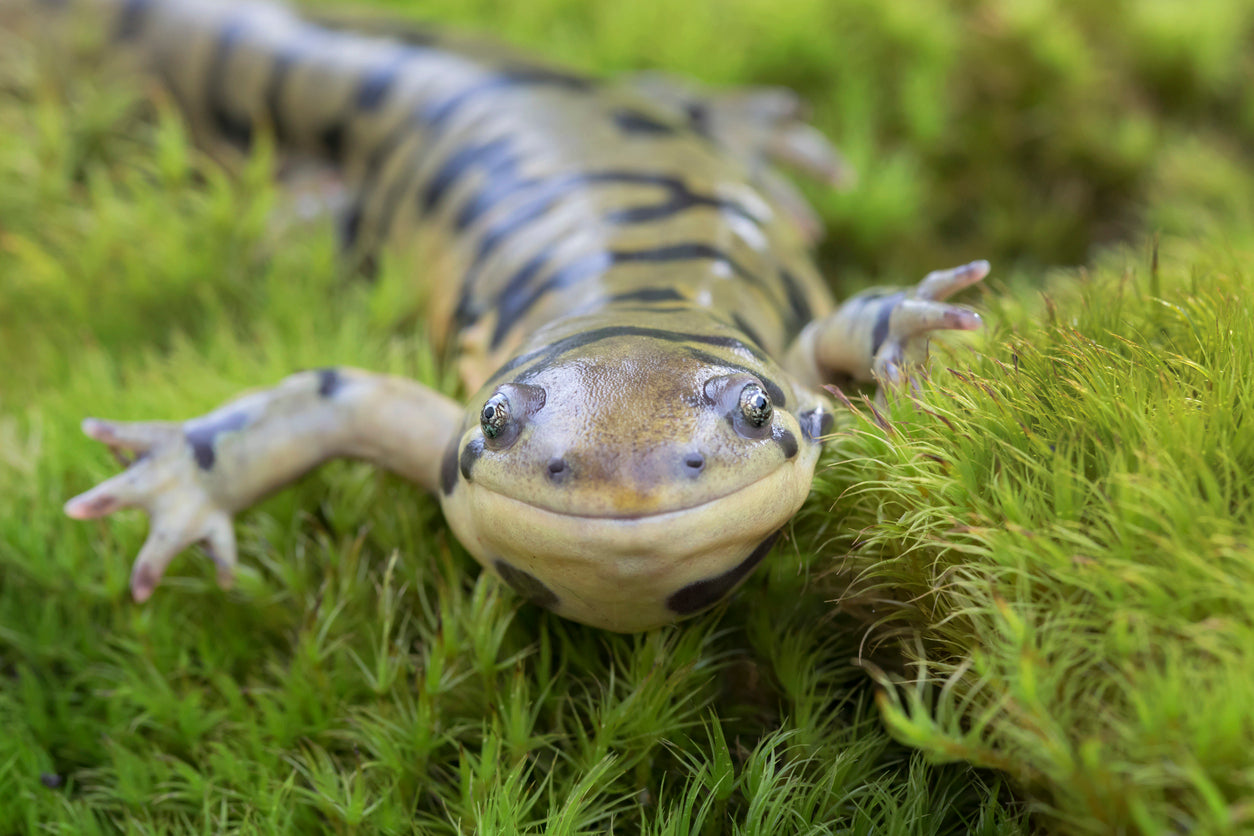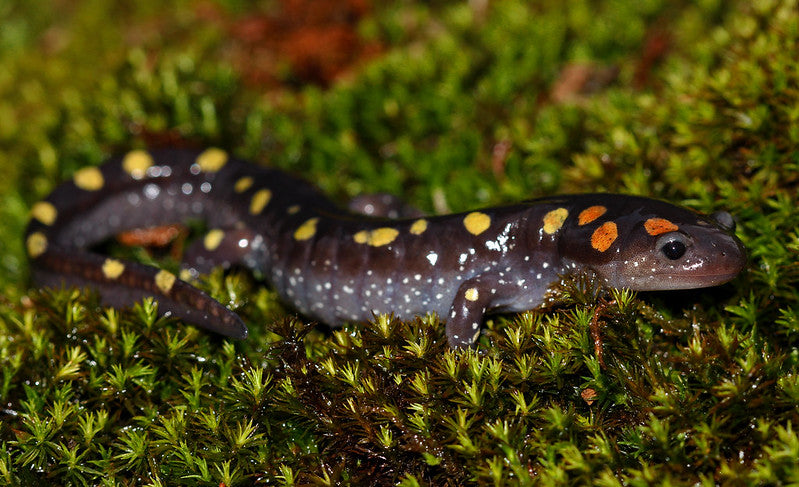Tiger salamanders (Ambystoma sp.) are large, nocturnal, terrestrial amphibians. They are widespread throughout North America, primarily in the United States, but also southern Canada and well into Mexico. Although generally associated with forest habitats, they can also be found in grassland or marsh areas.
Tiger salamanders are generally 9-11” long, but they are known to grow as large as 14”. They have a fairly typical mole salamander body, with a large rounded head, small bulging eyes, robust body, short limbs, and a thick, tapered tail. Appearance depends on the exact species, but they generally have a black base color with yellow or orange spots, blotches, or bands for pattern. Alternatively, they may have an olive base color with black markings.
Tiger salamanders are fairly easy to care for, and are one of the best options for people new to caring for amphibians. With good care, a pet tiger salamander can live up to 15+ years.
This care sheet is for mature tiger salamanders in their adult form. If you are raising a tiger salamander from its larval “water dog” form, you will need to provide care similar to that required for an axolotl. As the larva ages, provide access to an area of land so it can complete metamorphosis.
Note: Tiger salamanders are illegal to keep in some states. Please check your local laws before getting a pet tiger salamander.
How much space do tiger salamanders need?
Mature tiger salamanders are terrestrial, so they don’t need an aquatic area in their enclosure. The minimum size for housing a tiger salamander is 30”L x 12”W x 12”H, or a 20 gallon “long” tank. However, larger is preferred, as this is a large, fairly active salamander, and their territories in the wild are much larger. We also recommend using a front-opening rather than top-opening enclosure, as this makes maintenance easier and less stressful for the salamander.
Multiple tiger salamanders should not be housed together, as they are a naturally solitary species.
Do tiger salamanders need UVB?
They seem to be able to survive without it, but it’s still best practice to provide a small amount of UVB lighting for optimal health and wellbeing. Providing UVB lighting to your tiger salamander gives them all of the vitamin D that their body needs, stimulates better appetite and activity, and generally allows them to be healthier than they would be without.
The best UVB bulb for tiger salamanders in a 12” tall enclosure is likely to be the Zoo Med Mini Compact Fluorescent Reptisun 5.0, 13w. This bulb should be housed in a reflective fixture like the 12” Zoo Med Naturalistic Terrarium Hood, and placed on top of the mesh lid on one side of the enclosure. UVB bulbs decay over time, so don’t forget to replace your bulb every 12 months to maintain good performance.
UVB is blocked by glass and plastic, so you can’t give your pet UVB by placing its terrarium in front of an open window. This is also likely to heat the terrarium up to dangerous levels via the greenhouse effect!
Lights should be on for 14 hours/day during summer and 10 hours/day during winter to simulate natural seasonal cycles.
What temperatures do tiger salamanders need?
Tiger salamanders are ectotherms, which means that they rely on the temperature of their environment to help regulate their metabolism and stay healthy.
The enclosure temperature should be maintained between 50-75°F, and never warmer than 78°F, as this is likely to cause heat stress. Measure temperature with a digital probe thermometers, with the probe placed in the middle of the enclosure.
Because their preferred temperature is generally around room temperature, heating equipment is not likely to be necessary. However, make sure you have a reliable method of keeping the room consistently cool during summer if your home tends to get warm during that season.
What humidity levels do tiger salamanders need?
As amphibians, tiger salamanders are very dependent on water. However, once they have metamorphosed past their larval stage, they become poor swimmers and should not have a pool of water in their environment. Average air humidity should stay around 50-80%, as measured by a digital probe hygrometer.
It’s best practice to mist your salamander’s enclosure 1-2x daily with a sprayer to create the right humidity levels. Only use dechlorinated water. Amphibian-safe water conditioner such as Zoo Med Reptisafe is good for treating tap water before use.
What substrate is good for tiger salamanders?
Tiger salamanders require at least 4” of moisture-retentive substrate to cushion their bodies, facilitate burrowing, and help maintain healthy humidity levels. As an added perk, it also tends to make the enclosure more attractive.
This substrate should have small particles and hold moisture well, as tiger salamanders tend to accidentally ingest their substrate, and they depend on it for staying hydrated. It should also be able to support plant life if you are using live plants:
Avoid peat moss and soil mixes containing peat moss, due to this material’s natural acidity.
Remove waste daily. If you are not using a bioactive paludarium setup, substrate should be replaced every 3-4 months to maintain good hygiene.
What décor can you use in a tiger salamander terrarium?
It’s terribly boring (and stressful!) for a salamander to be stuck in an enclosure with nothing in it except substrate. It doesn’t matter how big the enclosure is if you don’t put things in it for your pet to use and interact with.
Décor options for tiger salamanders include:
- leaf litter
- mopani wood
- cork rounds and flats
- live or artificial plants
- pre-made hides/caves
- artificial ornaments
Whatever you choose to use, make sure that your pet has plenty of cover to hide under so they can feel secure in their environment.
What do tiger salamanders eat?
Tiger salamanders are insectivores, which means that they need to eat live insect prey in order to get the nutrition that they need. Your salamander should be fed 2-3x/week, as much as it will eat in roughly 10 minutes. Feeders should be smaller in width than the salamander’s head.
Food options for tiger salamanders:
Supplements
Tiger salamanders need vitamin and mineral supplements to enjoy optimal health. We recommend Repashy Calcium Plus LoD, lightly dusted on their prey at each feeding. Occasionally skipping a dusting is fine.
Do tiger salamanders like to be handled?
Very few amphibians actually “like” to be held, and salamanders are not one of them. Handling should be kept to an absolute minimum, but when you have to grab your salamander, wear a pair of nitrile gloves wet with spring water and gently coax them into a plastic container lined with wet paper towel. If you need to use your hands, wash them thoroughly, then wet with cold spring water water before handling. Always wash your hands after working with your salamander as well!
*This care sheet contains only very basic information. Although it’s a good introduction, please do further research with high-quality sources to obtain additional information on caring for this species.



Leave a comment
This site is protected by hCaptcha and the hCaptcha Privacy Policy and Terms of Service apply.